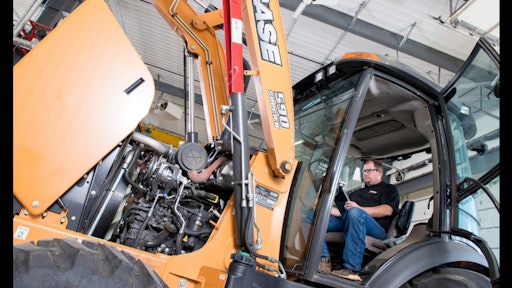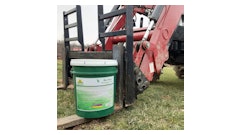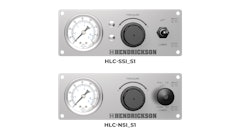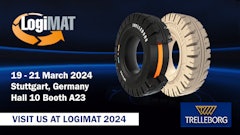
Demands on heavy-duty diesel engine oils have changed alongside engine technology and fuel formulations. “As engine technology and fuel technology have evolved, the environment in the crankcase has changed,” says Stede Granger, Shell Lubricants.
Twenty-five years ago, fuel sulfur levels hovered around 5,000 ppm. The sulfur would find its way past piston rings and down into the crankcase where it formed sulfuric acid. Additives in the oil were used to neutralize that acid. Depletion of additives was the determining factor for oil changes.
“Those were the days that we really looked at TBN,” says Granger, “and you were probably draining your oil on TBN counts.”
Then, sulfur levels dropped dramatically as it was regulated out of the fuel to the current 15 ppm. This created the next challenge — soot control. “Manufacturers started changing the ways diesel engines were set up and calibrated,” Granger explains. This resulted in a lot of fuel soot being formed in the crankcase. “That fuel soot would accumulate in the oil and it would have to be drained.”
[VIDEO] How to Pick the Right Diesel Engine Oil for a Mixed Construction Fleet
Then modern emissions equipment was introduced. The crankcase environment improved. “We got rid of the sulfuric acid,” notes Granger. “The new engines run at very low soot levels.”
The newest threat is now oil oxidation. “As the oil is exposed to higher temperatures, the oxygen that is in the crankcase can react, and in extreme cases it forms oxidation products that are somewhat acidic,” says Granger. “They also cause the oil to thicken up significantly.”
Viscosity is King
Engine oil needs to form a protective film, which prevents metal to metal contact. “An old axiom in the lubricants business is to use the lightest viscosity oil that will adequately protect the equipment,” says Tony Negri, heavy duty product director at Phillips 66. “It is important to note that there are multiple measures of viscosity, but the two most common are ‘kinematic’ and ‘absolute’.”
Kinematic viscosity is expressed as centistokes (cSt) and is a measure of resistance to gravitational flow. It is a primary component of how SAE oil grades are defined (15W-40, 10W-30, 5W-40, 5W-30, etc.).
Absolute viscosity is expressed as centipoise (cP). It is a measure of frictional drag within the lubricant as measured in the High Temperature/High Shear test, which is designed to emulate the area between the crankshaft and connecting rod journal bearings in a warmed up engine.
“Lower either or both of these values, and one should expect modest fuel economy improvements,” says Negri. “Fuel economy, though, is a complicated picture. An oil’s impact on fuel economy could range from 0.5% to 4% depending upon viscosity. However, fuel economy gains from oil selection can easily be minimized or eliminated if the vehicle experiences increased idle time or consistent driving patterns that impact efficiency, such as heavy traffic congestion, frequent jackrabbit starts and hard stops.”
[VIDEO] Why an Oil's Viscosity Index is Important
Measuring fuel efficiency gains in off-road fleets is difficult. “While most long-haul trucks have the luxury of running under steady state conditions on rural sections of interstate highways, off-road equipment rarely operates that way and it can be very difficult to tease out the impact of oil on fuel economy,” says Negri. “There tends to be much more idling, widely varying loads, temperature, terrains and other factors that can obscure a pure pursuit of fuel savings.
“Beyond fuel economy, lowering viscosity from 15W-40 to 10W-30 can often bring additional benefits such as reduced warm-up times and less wear at startup due to better oil flow and pumpability regardless of the season,” he adds.
But decreasing viscosity isn’t a simple solution. “Normally, the trade-off for going to a lower viscosity engine oil was concern around wear protection and engine durability,” says Len Badal, global brand manager at Chevron. “However, a number of off-road OEMs actually factory fill with SAE 10W-30 and we have customers who have successfully used 10W-30 and witnessed lower wear metals via used oil analysis — showing that lighter viscosity heavy-duty engine oil can still provide appropriate protection and long engine life durability.”
Key Considerations for Shifting to a Lower Viscosity Oil
For off-road diesel equipment, 15W-40 has been the predominant oil and likely will be into the foreseeable future. Off-road fleets tend to run in much more varied applications and there is often a wide spread in the age of the equipment.
“If it is older equipment and it has a lot of hours on it — maybe the bearings have larger clearances than they did when they were new because of the wear — you are probably best staying with the 15W-40,” says Granger. “You have to look at the equipment as a whole. Very few manufacturers, if any, have an issue with 15W-40. That viscosity grade has been on the market for a long time.”
Work in cold weather climates can also influence the best choice. “An ideal product if they don’t want to change oil when the temperatures warm up is a 5W-40,” says Granger. “It has the startup ability of an SAE 5W-type oil and yet the operating protection of an SAE 40 oil. That is a fully synthetic product. It adds a little expense, but it could make a difference between diesel equipment starting up or not starting during cold winter temperatures.”
For multi-grade oils such as 10W-30 or 15W-40, the W signifies Winter. “You should not be apprehensive about that number on the left of the W,” says Granger. “It defines how that oil performs at low temperature. For instance, a 5W-40 flows quicker through the engine in cold temperatures because of the 5W. At operating temperature when you need the protection, it performs the same as any SAE 40 oil.”
Consider the recommendations of a major off-highway manufacturer. “This equipment manufacturer recommends low viscosity engine oil SAE 5W-40 for temperatures ranging from -22° F to 120° F and SAE 15W-40 from +15° F to 122° F,” says Mark Betner, heavy duty product line manager, CITGO Petroleum Corp. “The significance of these recommendations is that the 5W-40 engine oil compares with the high temperature range of the 15W-40 oil but has a significant advantage at low temperature.”
New Oil Categories Emerge
For the first time in many years, the American Petroleum Institute (API) introduced a split diesel engine oil classification to address the diverging needs of engines stemming from new on-highway regulations.
“The difference between on-highway and off-highway diesels is that on-highway diesels must comply with the EPA Phase II GHG (greenhouse gases) and fuel efficiency standards beginning in 2017,” says Betner. “These standards require diesel engine manufacturers to certify their 2017 engines to meet the new fuel efficiency standards.”
New Oil Classifications Tackle Emerging Diesel Engine Technology
The CK-4 and FA-4 oil classifications replace the previous CJ-4 classification. They offer several enhancements, including increased resistance to oxidation and shear stability. In addition, the FA-4 is a niche classification that features a lower absolute viscosity for increased fuel economy.
“Going from CJ-4 to CK-4, and the lower viscosity FA-4, the biggest significant increase in performance is the oil’s oxidation resistance,” says Granger. “If we can get oxidation resistance, we should be able to extend the oil drains [on some of the newest engines].”
“With the new API CK-4 category launch, there is a high possibility that operators may be able to extend oil drain intervals further due to improved oil oxidation and wear performance of the new quality engine oils,” agrees Badal. “However, operators always need to check OEM recommendations and be sure to conduct used oil analysis when extending oil drain intervals.”
Engines that previously used CJ-4 can utilize CK-4. “Being completely back-serviceable, the new API CK-4 oils are low SAPS (sulphated ash, phosphorus, sulfur) formulations designed to protect the diesel particulate filters and other emissions components on Tier 4 and older Tier 3 engines just like the previous CJ-4 oils,” says Shawn Ewing, product technical services, Phillips 66.
CK-4 and FA-4 oils are actually quite similar. “Even though we have a split category, the actual performance requirements are the same,” says Granger. “Both oils have to pass the same engine tests, so it results in very similar chemistries.”
Filling with the incorrect product will not result in immediate engine failure. But the FA-4 oils do have a significantly lower viscosity and are not currently recommended for off-road use by OEMs.
Conventional vs. Synthetic
“Conventional means the engine oil uses only standard mineral-type base oils, whereas synthetic blend oil uses combinations of both synthetic and mineral oil,” says Betner. “Full synthetic oils use all synthetic base oils. Since synthetic oil can provide some performance advantages, such as resistance to oil oxidation and improved oil flow in cold temperature, this generally supports the basic premise that adding or substituting some or all synthetic to the engine will improve performance of the engine oil.
The Difference Between Synthetic and Conventional Oil
“However, there are many factors that should be considered and that is where the debate begins,” he continues. “The quality of the additive is a critical factor that impacts performance. The equipment owner should ask the engine oil provider for information to support the performance claims of the different engine oil options and the advantages of each when making a selection.”
According to Badal, synthetic blends or fully synthetic formulations generally:
- offer improved cold weather performance and startup;
- are required in formulating lower viscosity heavy-duty engine oil grades such as 10W-30, 5W-40, 5W-30 and 0W-40;
- hold potential for higher temperature performance (typically applies only to all-synthetic heavy-duty engine oil formulations).
“There is no doubt synthetic oils make a better product,” says Granger. “We believe the increase in performance is of value to the end-user customer. However, it depends on his or her application and how they are using the equipment.”
One consideration is that today’s engines typically run hotter, which creates more of an oxidation concern. “We are going into a new environment where we might get even more benefit from synthetic oils because of their inherently better oxidation resistance,” says Granger. “In the old days when you were generating a lot of soot, it almost didn’t make sense using a synthetic because you had to drain it to get the soot out. Now these engines are calibrated and the emissions technologies have come a long way.”
Synthetic oils tend to offer improved cold temperature properties. “If starting in colder temperatures is important, then the synthetic or semi-synthetic products offer benefits to the customer that are worth the difference in price,” Granger states.
There is no one right answer. “The most important factor here is to understand what goals you want to achieve with your maintenance program, then select the products that will provide the best value (performance vs. price),” advises Ewing. “Conventional oils provide ‘meets spec’ attributes at a comfortable price point, but may not allow for extended drain intervals or be the best fit for severe-duty applications. Carrying with them a premium price, full synthetic formulations offer very predictable performance attributes and perform best at very high and very low temperatures as well as severe-duty service.
“Synthetic blend formulations offer an attractive compromise between the two as they are often a good fit for severe-duty service and extended drain intervals while being competitively priced,” Ewing points out, adding, “None of the categories are by definition good or bad. It’s just a matter of selecting the product features that best fit your needs.”





























